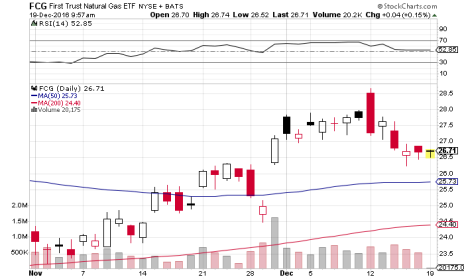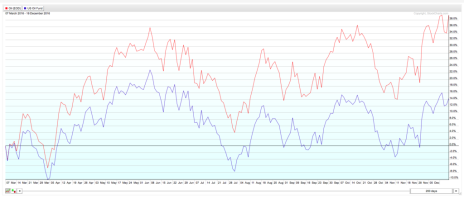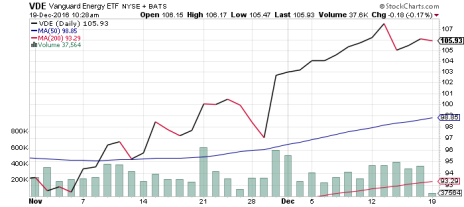Thanks to OPEC, crude oil prices are rising again, topping $52 for the first time in 18 months. That’s unwelcome news if you drive just about any car other than a Tesla (TSLA)—gas prices are up six cents this month. But it’s good for energy investors. The trick is knowing how to invest in oil above $50.
The most efficient way to do it is through oil ETFs.
How to Invest in Oil? Try These Three ETFs
As we so often say here at Cabot Wealth, we’re stock pickers. We prefer to recommend individual stocks— growth stocks, value stocks, small-cap stocks, etc. However, there are occasions when we recommend exchange-traded funds (ETFs). One of those occasions is when there’s a red-hot sector and you want to take full advantage of its momentum. Rather than pick one or two stocks, it can make sense to buy an ETF that tracks a whole basket of stocks in that sector.
[text_ad]
That’s why oil ETFs look so appealing right now. Oil prices are tracking about as far above their 50-day moving average ($48) as they have in two years. Until it drops below that average, oil is a good momentum play.
There are a number of oil ETFs that have been making strong moves amid the six-week run-up in crude oil. Here are three that stand out:
First Trust ISE-Revere Natural Gas Index Fund (FCG)
As the name suggests, this ETF doesn’t hold only oil stocks; FCG tracks the stock performance of 100 crude oil and natural gas producers. It counts Devon Energy (DVN), Hess (HES) and Marathon Oil (MRO) among its 10 largest holdings. That diversity allows FCG to take advantage of the rally in natural gas prices (+31% since November 11) and crude oil. The result is an ETF that is up nearly 14% since election day.
Here’s FCG’s chart looks like since the beginning of November:
FCG topped out around 28 earlier this month, and has since pulled back to support in the high 26s. This could be an ideal entry point, especially if oil and natural gas prices keep inching upward.
United States Oil Fund LP (USO)
USO is the best pure-play fund that tracks crude oil prices. It’s the largest, most liquid of futures-backed oil ETFs, with 30 million shares exchanging hands daily (more than that recently) and more than $2 billion in assets.
Over the past five years, USO has had a 0.96 correlation (1.0 is the highest) with crude. Just look:
Not surprisingly, the fund has risen almost in lockstep with crude oil prices over the last six weeks. USO bottomed below 10 in early November, broke above its 50-day moving average just after Thanksgiving, then continued kiting higher until last week, where it met resistance above 11.7 before getting briefly knocked back.
A little over two years ago, when crude oil was $100 a barrel, USO traded in the high 30s. It’s 18% since oil prices starting rising on November 11 (crude oil is up 22%). Basically, if oil prices continue to ascend once OPEC’s production cuts take effect, so will USO.
Vanguard Energy ETF (VDE)
As I referenced earlier with natural gas, it’s not just oil prices that are on the rise; the entire energy sector has been bouncing off multi-year lows. With 150 stocks, the Vanguard Energy ETF gives you exposure to every facet of the energy-sector rally.
Some of the usual suspects are among the VDE’s biggest holdings: Exxon Mobil (XOM), Chevron (CVX) and ConocoPhillips (COP). Still, oil companies only make up 46% of the fund.
Like other energy ETFs and stocks, the VDE started to make its move in early November, bouncing off 92. It gapped up from 97 to 103 the first day of December, and kept on trucking to as high as 108 last week, before dipping back to the 105-106 range. Even after the pullback, the fund is still up 14% since November 4.
And the longer energy remains a popular rebound play on Wall Street, the better the chances of another VDE breakout.
Bottom Line
Now that you know how to invest in oil and where to invest in oil, pay close attention to what’s actually happening with oil prices. If they slip back below $50 a barrel—and especially if they sag below their 50-day moving average in the mid-$48 range—the three ETFs mentioned above, and energy stocks in general, will head south in a hurry.
Despite the lower prices, oil still has much more use in today’s society than gold, silver and other commodities—but it can be just as fickle. Thus, take the cautious, short-to-intermediate-term approach when investing in oil. Oil is a momentum play right now, and the rules of how to invest in oil include knowing when to get in—and, more importantly, when to get out.
[author_ad]



